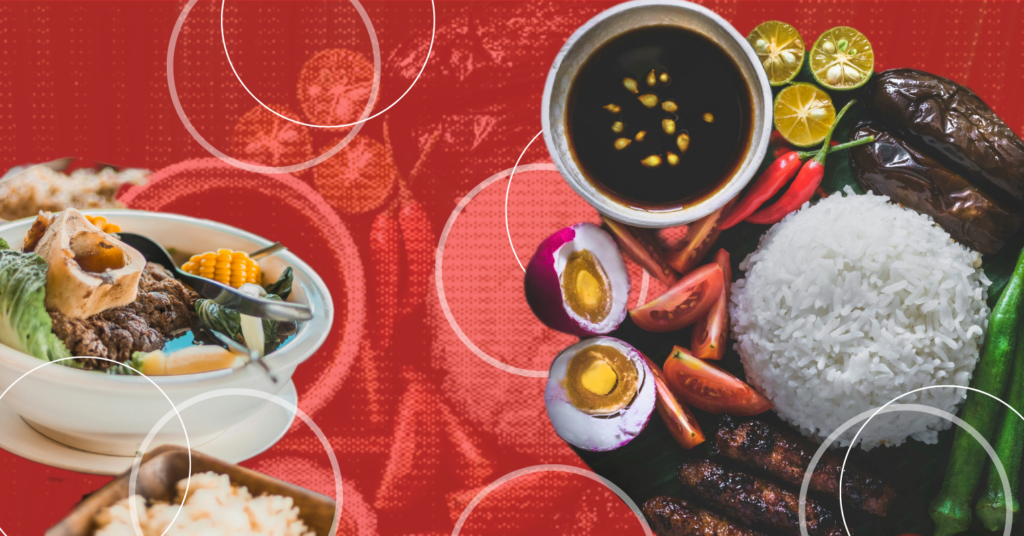Welcome to EnVi Eatery! Shield yourself from the cold this winter by trying something new. In this edition, we list some staple Filipino comfort foods that are perfect for winter. Whether you’re feeling sick or craving something to warm you up, this list provides you with everything you need to know about each Filipino dish. This edition of EnVi Eatery is coming in hot with a small side of history.
Sinigang
Starting the list off with the Philippines’ unofficial national dish, we have Sinigang. This hearty soup is known for its distinctive sourness created by tamarind. This dish is believed to be indigenous to the country, predating colonization because all of the ingredients can be found in every region of the Philippines. Sinigang is a versatile dish you can make with whatever is available to you. This recipe follows how to make pork sinigang, but you can use a protein of choice, like beef or fish.
Ingredients (for 6 servings):
- String beans (typically 8-12 pieces or to your liking)
- 1.5 lb pork belly
- 3 small tomatoes
- Bunch of kang kong (chinese spinach) or spinach (bok choy as a substitute)
- 2 pieces of taro cut in quarters (or diced potatoes as a substitute)
- 1-3 pieces of chili (to your liking)
- 1 tablespoon of cooking oil
- 2 quarts of water
- 1 piece of onion sliced
- 3 tablespoons of fish sauce
- 1 pack of sinigang mix
- Cooked white rice
Directions:
- Heat the pot then put in 1 tbsp of cooking oil. Sauté the onion until its layers separate.
- Add in the pork belly and cook until light brown.
- Mix in 3 tbsp of fish sauce.
- Pour in the water to the mix and bring to a boil.
- Mix in the taro and tomatoes and let it simmer until the pork is tender.
- Put in the sinigang mix and chili.
- Add in the string beans and let it simmer for 5 to 8 minutes.
- Turn off the heat, add in the spinach, then cover the pot. Allow the spinach to cook in the leftover heat of the pot.
- Serve hot with a side of rice and enjoy!
- (Optional) Can also be enjoyed with a side saucer of fish sauce to amplify the taste!
Arroz Caldo
This lugaw, or “porridge,” is a soothing remedy for when you’re feeling sick but also delivers a spicy kick without burning your tongue too much! Arroz caldo is an adaptation of congee, which was introduced by Chinese tradesmen in pre-colonial times. The dish was later named arroz caldo, translated to “rice broth,” by the Spanish, who were not interested in learning its Chinese name. This recipe is a classic, and one that can become a staple in your winter comfort food rotation.
Ingredients (For 6 servings):
- 1 ½ lbs chicken cut into serving pieces
- 1 ½ cups uncooked rice
- 34 ounces water
- 2 tablespoons of fish sauce
- 1 teaspoon garlic
- 1/4 teaspoon ground black pepper
- 1 cup minced onion
- 2 knobs ginger
- 3 tablespoons safflower kasubha
- 1 chicken cube bouillon
- 1 lemon or 4 pieces calamansi (if preferred)
- 2 tablespoons of cooking oil
- 1 cup scallions, minced
- 2 hard boiled eggs cut into halves (optional)
Directions:
- Pour in and heat the cooking oil in a pot. Then put in and sauté the garlic, onion, and ginger.
- Add a dash of ground black pepper. Then add in the chicken bouillon cube and cook until melted.
- Put in the chicken and cook until golden brown.
- Pour in the fish sauce and uncooked rice then mix and let it cook for a few minutes.
- Pour in the water and bring to a boil.
- Stir occasionally until rice is fully cooked.
- Add in a pinch of safflower for color.
- Optional step: add in the hard boiled eggs.
- Serve with garlic, minced scallions, and sliced lemons. Enjoy!
Note: The last three steps can be done to your liking.
Chicken Sotanghon Soup
The simplicity of this classic Filipino chicken noodle soup will have you craving it when you’re lacking appetite or simply wanting something warm to eat. One of its distinct ingredients is mung bean noodles, also known as glass noodles or cellophane noodles. These noodles were brought over from China and swiftly integrated into daily Filipino cuisine.
Ingredients (for 6 servings):
- 6 oz mung bean thread noodles
- 1 ½ tablespoon of grape seed oil
- 4 minced garlic cloves
- 1 tablespoon of minced fresh ginger
- 1 medium onion chopped (about 1 ½ cups)
- 1 lb of skinless chicken breast cutlets
- 1 ½ cup of thinly sliced shiitake mushrooms
- 10 cups homemade chicken broth (use store bought for convenience)
- 1 teaspoon of kosher salt
- Freshly ground black pepper
- Chopped green onions
Directions:
- Here is a separate recipe on how to prepare homemade chicken stock.
- In a separate bowl, soak the mung bean thread noodles in warm water for 10-15 minutes.
- Heat oil in a large pot over medium high heat. Once the oil is heated, add in garlic and ginger and stir. After about 30 seconds, mix in the onions.
- After about 2 minutes of stirring, add in the raw chicken to cook. Turn chicken as needed.
- Put in the mushrooms and let them cook for 2 minutes. Continue to stir.
- Pour in the chicken broth. Remove cooked chicken from the broth and place onto a cutting board to shred the chicken or dice it if you prefer. Let the broth boil for 2 minutes then let it simmer.
- Add shredded or cut chicken back into the pot. Season with salt, as needed.
- Drain soaked noodles, add to the pot, and stir. Start to boil the soup for about 2 minutes. Reduce heat to let the soup simmer for 3-5 minutes.
- Season with some black pepper and salt to your liking, and serve with chopped green onions. Done!
Bulalo
Bulalo is a beef soup well known for its collagen properties, which comes from the bone of the beef. This dish originates from Southern Luzon in the Philippines, a region known for its cattle farms. Despite the lengthy preparation and cooking time, the savory soup allows you to enjoy the rewards of your efforts! To balance the tanginess of the meat and broth, this dish is often paired with soup.
Ingredients (for 4 servings):
- 3 lbs beef shank
- 1 onion cut into quarters
- 2 tablespoons fish sauce
- 1 tablespoon peppercorns
- 2 ears of corn cut into halves
- 1 bunch of pechay (chinese cabbage) with the leaves separated
- 2 green onions cut into halves
- Salt, to your discretion
Directions:
- In a large pot, put the beef shanks and pour in cold water enough to cover. Heat water to a boil.
- To remove impurities, drain the pot and rinse beef in cold water. Discard liquid and wash pot.
- Put the beef back into the pot and fill with cold water. Bring to a boil again for about 3 hours. Skim and remove the fat that floats to the top periodically.
- After the broth has cleared, mix in onions, fish sauce, and peppercorns.
- Cover the pot and lower the heat to let the soup simmer for 1 ½ to 2 hours until the meat is tender but not falling apart.
- Add corn and let it simmer for 10 to 15 minutes until the corn is tender. Then add the pechay and green onions and cook for another 3 minutes.
- Season with salt to your liking. Serve hot with a side of rice and fish sauce. Enjoy!
Champorado
If you’re craving something sweet, this dish is perfect to warm you up on a cold day. Different from the previous soups, champorado is a sweet porridge, made with chocolate and glutinous rice. “Champurrado,” a hot chocolate drink indigenous to Mexico, was first introduced through trade during the Spanish colonial era. Eventually, this hot chocolate beverage transformed into the Filipino dish known as “champorado,” incorporating glutinous rice to form a porridge. Over time, the addition of evaporated milk further enhanced its sweetness. This is a fast and easy dish to make and is typically served for breakfast or as a snack.
Ingredients (for 3 servings):
- About 2.5 cups of water
- ½ cup of glutinous rice
- 2 pieces tablea chocolate (about ½ cup of cocoa powder unsweetened as a substitute)
- ¼ cup of sugar (optional)
- ¼ cup of evaporated milk
Directions
- Pour water into a deep pot and bring to a boil on medium heat.
- Lower the heat and add the rice. Stir until rice expands.
- Add in the tablea (or cocoa powder) and continue to stir until the chocolate mixes in. Continue to cook and stir until desired consistency is reached. This is typically when the rice becomes soft and the liquid reduces.
- To adjust the sweetness to your liking, add sugar and stir until it’s completely absorbed.
- Pour into separate bowls, drizzle the evaporated milk on top and you’re finished!
Try out one of these delicious dishes to combat the cold and stay cozy this winter!
Interested in quick and easy recipes? Check out four vegetarian bean recipes here!




